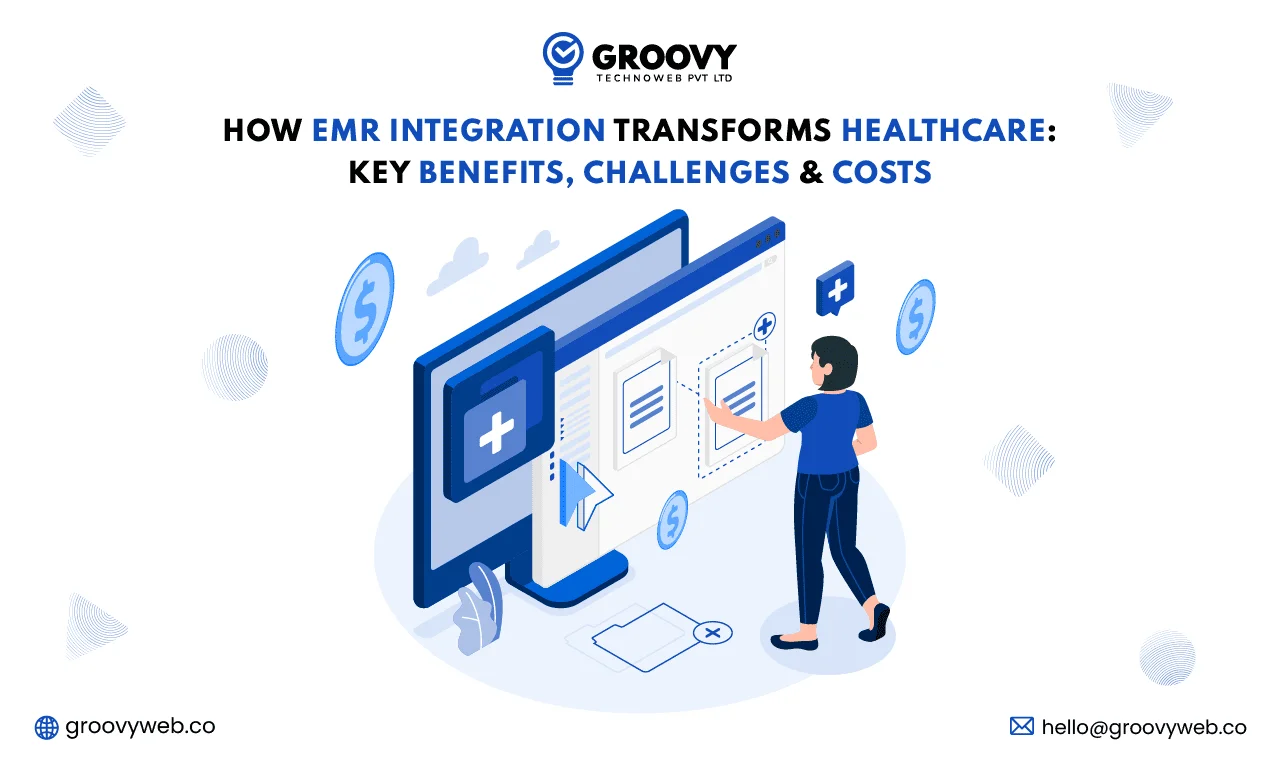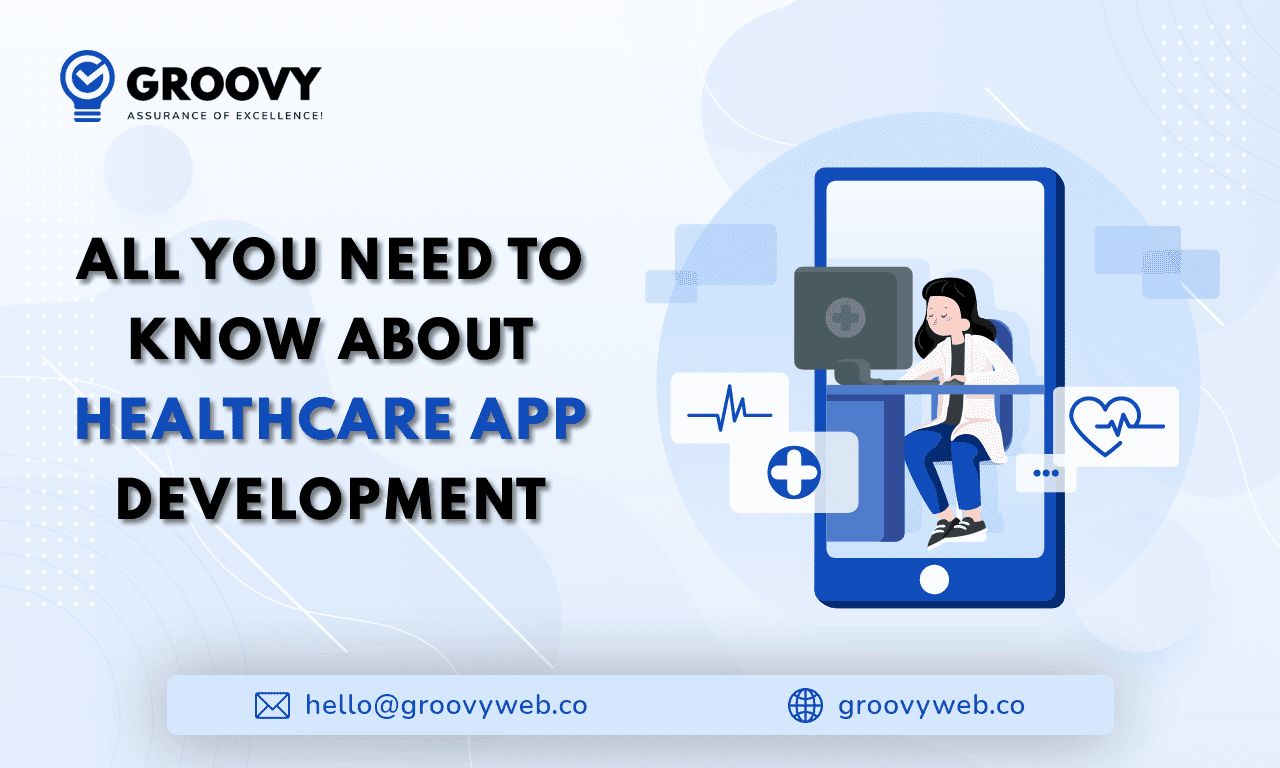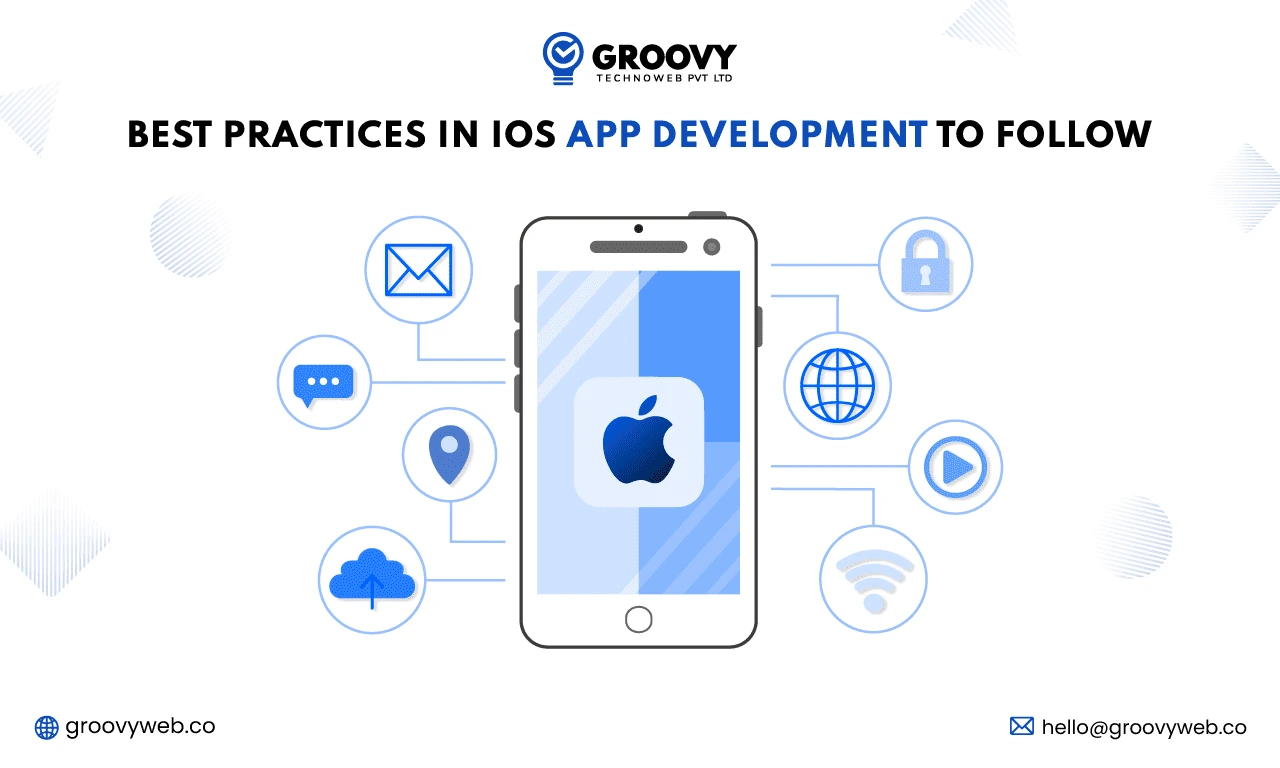EMR Integration in Healthcare: Benefits, Challenges & Costs
Ashok Sachdev
March 22, 2025 79 Views
Quick Summary : EMR integration in healthcare is a very useful technique as it helps improve patient care, and the patient also gets access to their medical history, so they can better understand and think about their diseases. It also helps the doctors get the patient's medical history in emergencies. Although it is quite difficult to set up EMR integration initially, as the costs are too high, it is very effective in the long run, as it helps save a lot, such as not relying on paperwork, etc. Also, there is another challenge: there has to be a proper cybersecurity system to prevent any breaches.
In the fast-paced healthcare environment of today, Electronic Medical Record (EMR) integration is a game-changer for hospitals, clinics, and doctors. While healthcare organizations strive to enhance patient care, simplify operations, and comply with regulations, EMR systems offer a sound solution to handle medical records electronically.
Integration of EMR allows open communication among different healthcare IT systems and allows healthcare professionals to access, edit, and exchange patient records in real-time. This increases efficiency while ensuring that the patient receives accurate, timely, and coordinated care.
According to research, the global EHR market was valued at $30.55 billion in 2020 and is projected to reach $63.85 billion by 2030, registering a CAGR of 7.7%.
Here, we will discuss:
- The basics of EMR integration
- Major advantages of having an EMR system
- Critical features that make EMRs successful
- Challenges and expenses of EMR adoption
- Best practices for smooth integration
- Emerging trends that drive the future of EMR technology
With time passing, there has been a lot of development in the medical field. This development has been possible due to the use of technology in the medical field. The medical field has used IT services and technology to enhance itself.
Various IT facilities, one of them being EMR (electronic medical record), are being widely used across the globe. With the help of electronic medical records, doctors can connect and discuss the patient’s health and provide better treatment.
Most medical professionals use data-driven decision-making strategies. That is the importance of EMR in the medical field has increased. However, the implementation of EMR is not an easy task. It has many challenges such as initial setup costs, cyber security measures, etc.
In the fast-paced healthcare environment of today, Electronic Medical Record (EMR) integration is a game-changer for hospitals, clinics, and doctors. While healthcare organizations strive to enhance patient care, simplify operations, and comply with regulations, EMR systems offer a sound solution to handle medical records electronically.
You will understand how EMR integration transforms healthcare and why it is an important investment for healthcare providers by the end of this article.
What is EMR Integration?
Electronic Medical Record (EMR) integration refers to the seamless incorporation of EMR systems with other healthcare IT services as well as medical software solutions. With integration, healthcare providers are able to store, access, and share patient information in real-time, which leads to better decision-making and patient outcomes.
EMR integration enables different systems such as laboratory management, billing, radiology, and telehealth platforms to communicate with each other efficiently without manual intervention. This avoids information silos and enables an integrated healthcare environment where any patient information can be accessed through a single portal.
How EMR Integration Works
EMR integration is the process of connecting different healthcare software development systems into a single digital repository for patient records. The integration process generally involves:
- Data Standardization – Making the patient data in a formatted manner so it becomes accessible on different systems.
- Interoperability – Applying Health Level Seven (HL7) standards or Fast Healthcare Interoperability Resources (FHIR) protocols to facilitate communication between multiple healthcare platforms without any obstacles.
- APIs and Middleware – Application Programming Interfaces (APIs) and middleware options enable secure, efficient data interchange between EMRs and outside systems.
- Data Security & Compliance – Using HIPAA-compliant security measures and encryption to safeguard patient data from compromises.
Types of EMR Integrations
EMR integration can be divided into different types depending on the extent of system connectivity:
- One-Way Integration – Data travels in one direction, e.g., lab reports being automatically synchronized in an EMR system.
- Two-Way Integration – Real-time data exchange in both directions where systems may send and receive information.
Example: An EMR of a hospital integrating with a pharmacy system to send out prescriptions and get updates on fulfillment.
- Cloud-Based EMR Integration – Utilizes cloud technology to integrate various healthcare facilities so that patient records can be accessed from anywhere.
Why EMR Integration is Essential for Healthcare
Without integration, healthcare providers encounter the following obstacles:
- Redundant data entry, resulting in inefficiency
- Protracted access to vital patient data
- Medical errors stemming from miscommunication across departments
- Regulatory compliance failures with regard to patient data security
By integrating EMRs with other healthcare systems, providers can remove these obstacles and provide enhanced patient care, more efficient workflows, and greater operational efficiency.
Key Benefits of EMR Integration
Electronic Medical Record (EMR) integration has revolutionized the healthcare sector by enhancing efficiency, patient care, and data management. By integrating various healthcare IT systems in a seamless manner, EMR integration facilitates better medical decision-making, minimizes errors, and maximizes operational workflows. The following are the major advantages of integrating EMR into healthcare systems.
1. Improved Patient Care & Safety
EMR integration allows real-time viewing of full patient medical histories, such as allergies, medications, lab results, and past diagnoses. This yields:
- Correct Diagnoses & Individualized Treatment Plans – Doctors make informed decisions using current patient information.
- Fewer Medical Mistakes – Automated reminders reduce medication mistakes and drug interactions. Medical face shields, like masks, also play a role in patient safety.
- Quicker Emergency Response – During life-or-death situations, ready access to the medical history of a patient can mean the difference between life and death.
Stat: A journal article published by the Journal of Patient Safety demonstrated that EMR systems lower rates of medical mistakes by as much as 86%, enhancing general patient safety.
2. Increased Efficiency & Productivity
EMR integration streamlines back-office work, eliminating paperwork and allowing healthcare professionals to spend more time caring for patients. Some of the most significant advancements are:
- Quicker Documentation – Less time is spent by physicians in doing manual data entry.
- Automated Scheduling & Billing – Decreases administrative workload and enhances revenue cycle management.
- Reduced Redundant Tests – Centralization of patient information avoids redundant lab tests and imaging scans.
Stat: EMR adoption among hospitals was accompanied by a 30% growth in physician productivity, reported by the National Center for Biotechnology Information (NCBI) report. According to research, telehealth utilization has stabilized at levels 38 times higher than before the pandemic, accounting for 13% to 17% of all outpatient visits across various specialties.
3. Enhanced Data Accessibility & Collaboration
With EMR integration, medical data is stored in a centralized system that can be accessed by authorized healthcare providers across different departments or even hospitals. Benefits include:
- Seamless Inter-Department Communication – Lab results, prescriptions, and imaging scans are instantly available to doctors.
- Better Coordination Among Specialists – Multiple physicians can collaborate on patient treatment in real time.
- Remote Access to Patient Data – Physicians can view records from any location, improving telemedicine services.
Stat: Research from HealthIT.gov states that 75% of healthcare providers believe EMR integration has improved communication across medical teams.
4. Better Security & Compliance with Healthcare Regulations
EMR systems have in-built security measures that safeguard patient information and meet laws like:
- HIPAA (Health Insurance Portability and Accountability Act)
- GDPR (General Data Protection Regulation)
- HITECH Act (Health Information Technology for Economic and Clinical Health)
Security features include:
- Data encryption to avoid unauthorized access
- Role-based access control to limit sensitive patient information
- Audit trails to monitor who accessed or altered information
Stat: The U.S. Department of Health and Human Services stated that integrated EMR systems lower data breaches by 40% as a result of increased security measures.
5. Significant Cost Savings
Even though EMR integration is an initial investment, it saves costs in the long run by:
- Removing Paper Records – Reduces printing, storage, and handling paper-based files costs.
- Avoiding Billing Mistakes – Automated billing eliminates wrong claims and rework expenses.
- Decreasing Hospital Readmissions – Correct patient records assist in improved diagnosis, minimizing avoidable hospitalization.
Fact: Estimated annual savings between $5 million to $10 million after implementing a computerized physician order entry system, which also reduced serious medication errors by 55%. Similarly, another large hospital reported approximately $8.6 million in yearly savings by replacing paper medical charts with electronic health records for outpatients and about $2.8 million annually by establishing electronic access to laboratory results and reports.
Essential Features of EMR Integration
An effectively integrated Electronic Medical Record (EMR) system improves data management, patient care, and operational efficiency, along with enhanced safety and financial management. The following are the main characteristics:
- Centralized Patient Records – One single database contains medical history, prescriptions, test results, and treatment plans, with real-time updates and minimal chances of error.
- Interoperability with Health Systems – Integration with LIS, RIS, PACS, e-Prescriptions, and billing systems increases workflow efficiency. 89% of healthcare systems have improved patient care through interoperability.
- ️ E-Prescription & Medication Management – Allows direct pharmacy prescriptions, identifies drug interactions, and avoids duplicate prescriptions.
- Clinical Decision Support System (CDSS) – Artificial intelligence-driven recommendations alert doctors to drug interactions, suggest diagnoses, and improve early treatment, lowering hospital readmissions.
- Automated Billing & Insurance Processing – Streamlines billing and claims, eliminating errors and accelerating reimbursements.
- Patient Portals for Self-Service – Patients can access medical records, book appointments, order refills, and communicate with physicians through the internet.
- Mobile Access for Remote Healthcare – Facilitating telemedicine, virtual visits, and remote prescriptions, with telehealth adoption expected at 38%.
- Data Security & Compliance – Comprising encryption, multi-factor authentication (MFA), and security audits to satisfy HIPAA & GDPR, safeguarding patient information.
Challenges of EMR Integration
Though EMR integration improves healthcare effectiveness, it entails various technical, financial, and operational challenges. Below are the major challenges and solutions:
High Costs of Implementation
Implementing EMRs requires software licensing, hardware, customization, staff training, and data migration, which entails a high capital outlay.
Solution: Select cloud-based EMRs to decrease infrastructure costs, take advantage of government incentives, and implement phased implementation to cost-effectively handle expenses.
Data Migration & Compatibility Problems
Most healthcare organizations are unable to migrate data from older systems, leading to inconsistencies in formats, data loss, and integration with current platforms.
Solution: Utilize standard data exchange protocols, perform data audits, and hire integration experts to migrate smoothly.
Interoperability Issues
EMRs should be able to communicate smoothly with other healthcare systems, but there is usually lack of standardized data protocols and vendor limitations that hamper data exchange.
Solution: Select interoperable EMRs, use middleware solutions, and foster cooperation among healthcare service providers for enhanced data-sharing.
Staff Resistance to Change
Staff can resist EMR implementation because of high learning curves, added workload, and unfamiliarity with new systems, resulting in inefficiencies.
Solution: Offer extensive training, intuitive EMR interfaces, and IT support to facilitate easy adoption.
Security & Compliance Risks
Since EMRs contain sensitive patient information, they are susceptible to cyber attacks, unauthorized access, and failure to comply with healthcare regulations.
Solution: Use multi-factor authentication, encryption, role-based access control, and perform periodic security audits to safeguard patient information.
Downtime & Disruptions
Hospitals can experience temporary system downtime during integration, resulting in delayed access to patient records, appointment disruptions, and financial losses.
Solution: Phase in EMRs, integrate during off-peak hours, and have backup systems in place to avoid workflow disruptions.
Scalability & Future-Proofing
Most EMRs do not have the capability to scale with growing healthcare facilities, so it is hard to incorporate new AI-based technologies, telemedicine, and remote monitoring devices.
Solution: Opt for cloud-based, modular EMRs that provide easy upgrades and technology integrations to accommodate future growth.
Cost Analysis of EMR Integration in healthcare
The integration cost of EMR varies on the size of the facility, deployment type, level of customizations, and compliance needs. Cloud-based options have lower initial costs, while on-premises solutions are more customizable but need greater investment. Other costs involved are employee training, data migration, security, and maintenance.
Hidden expenses like downtime, system upgrades, and short-term productivity loss may affect budgets. To reduce costs, healthcare facilities should utilize phased implementation, take advantage of government incentives, and spend money on staff training.
Even with the investment, EMRs enhance billing effectiveness, physician productivity, and patient care, and EMRs are a worthwhile long-term investment for healthcare facilities.
Future Trends in EMR Technology
The future of Electronic Medical Records (EMR) is determined by AI, cloud computing, blockchain, and IoMT. AI-based EMRs minimize human errors, automate reports, and enhance predictive medicine. Cloud-based EMRs offer scalability, remote access, and increased security, while blockchain offers tamper-proof records and secure data transfer. Integration with wearable devices (IoMT) offers real-time monitoring of patients, reducing hospital visits. Patient self-service portals increase patient engagement by offering access to appointments and records. Finally, interoperability is still a major challenge with attempts to enhance data exchange between systems. These developments will make EMRs efficient, secure, and patient-centric, informing the future of healthcare.
Final Thoughts
EMR integration is transforming healthcare by improving patient care, operational efficiency, and security. From workflow automation to real-time monitoring of patients, today’s EMRs are streamlining healthcare more than ever before. Success does require, though, choosing the right vendor, ensuring interoperability, and following best practices like phased rollout and staff training.
By adopting these EMR integration systems, the hospitals can opt for better operational efficiency to improve patient outcomes. Also, it is difficult to establish the startup due to high investment quotes. Still, later it is very cost-effective because it reduces the paperwork and manual writing, and due to this, the professionals can focus more on patient healthcare. We specialize in custom healthcare software development, including secure EMR integration, telemedicine platforms, and AI-powered healthcare analytics. Our team ensures seamless interoperability, compliance with HIPAA & GDPR, and future-ready solutions to streamline healthcare operations.
With the health industry moving towards AI-driven, cloud-based, and blockchain-secured EMRs, it is critical for clinics and hospitals to be in the lead. If your healthcare facility wants to implement EMRs with ease, our Healthcare IT Services and Medical Software Solutions provide complete solutions from choosing the best to implementing them and optimizing them. As a leading custom software development company, we offer custom telemedicine app development that seamlessly integrates with EMR systems, ensuring compliance with HIPAA and GDPR while enabling secure video consultations, e-prescriptions, and remote patient monitoring.
Looking to revolutionize your health care system using advanced EMR solutions? Contact groovy web now and see how we can help you obtain flawless integration as well as maximized efficiency!
Written by: Ashok Sachdev
Ashok Sachdev is the Project Manager at Groovy Web who began his professional career as a programmer at the young age of 17. Ever since then he is actively growing, learning new things, and adapting to new roles and responsibilities at every step. Aside from being an app developer, he is highly admired for his project management skills by his clients.
Frequently Asked Questions
We hope these clear your doubts, but if you still have any questions, then feel free to write us on hello@groovyweb.coWhat challenges does EMR integration face?
EMR integration faces various challenges. One is the set up cost, as the initial set up costs of EMR integration are high. Still, the benefits outweigh the high initial setup cost, as there are many benefits and other challenges, such as cyber security, as the patient's personal information may be leaked. For this, the EMR integration system management has to take Certain cyber security measures.
How is there a reduction in healthcare cost by EMR integration?
There is a reduction in healthcare costs as there is a reduction or complete vanishing of paperwork, and it also prevents the duplicate test. The professionals also have real-time access to the patient's reports in an emergency.
Related Blog

Krunal Panchal
All You Need to Know About Healthcare App Development
Healthcare 09 Apr 2025 11 min read
Rahul Motwani
Best Practices for IOS Mobile App Development
Mobile App Development 05 Mar 2025 9 min read
Rahul Motwani
Why Recruitment Portal Development Can Streamline Your Hiring Process
Mobile App Development 18 Dec 2024 9 min readSign up for the free Newsletter
For exclusive strategies not found on the blog